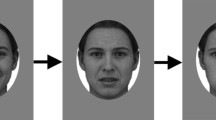Abstract
The study was designed to explore factors related to negativism in autistic children, where negativism was defined as the consistent avoidance of a correct response in a multiple choice discrimination task. A design employed in an earlier study of autistic children (Cowan, Hodinott, & Wright, 1965) was modified to allow a more detailed examination of patterning of the child's responses. A positive relationship was found between use of spoken language and successful performance of the task. However, no child was negativistic. Of the 27 children tested, 18 had a near perfect performance and 9 scored at chance level. A subsequent exact replication of the Cowan et al. method still failed to produce any negativism. A further study using a more difficult discrimination task produced a higher rate of errors but still no negativism. Possible reasons for the failure to replicate are discussed.
Similar content being viewed by others
References
Alpern, G. D. Measurement of “untestable” autistic children.Journal of Abnormal Psychology, 1967,72, 478–486.
Anthony, E. J. An experimental approach to the psychopathology of childhood: Autism.British Journal of Medical Psychology, 1958,31, 211–225.
Anthony, E. J. Low grade psychosis in childhood. In B. W. Richards (Ed.),Proceedings of the London conference for the scientific study of mental deficiency (Vol. 2). Dagenham, England: May & Baker, 1962.
Cowan, P. A., Hodinott, B. A., & Wright, B. A. Compliance and resistance in the conditioning of autistic children: An exploratory study.Child Development, 1965,36, 913–923.
DeMyer, M. K. Motor, perceptual-motor and intellectual disabilities of autistic children. In L. Wing (Ed.),Early childhood autism (2nd ed.). Oxford: Pergamon, 1976.
Des Lauriers, A. M., & Carlson, C. F.Your child is asleep: Early infantile autism: Etiology, treatment and parental influences. Homewood, Illinois: Dorsey Press, 1969.
Ekstein, R., Bryant, K., & Friedman, S. W. Childhood schizophrenia and allied conditions. In L. Bellak (Ed.),Schizophrenia. New York: Logos Press, 1958.
Gajzago, C., Prior, M., & Plant, M.Research in childhood psychosis. Oxford: Pergamon, in press.
Gittleman, M., & Birch, H. G. Childhood schizophrenia: Intellect, neurologic status, perinatal risk, prognosis and family pathology.Archives of General Psychiatry, 1967,17, 16–25.
Goldfarb, W.Childhood schizophrenia. Cambridge, Massachusetts: Harvard University Press, 1961.
Hutt, S. J., Hutt, C., Lee, D., & Ounsted, C. A behavioural and electroencephalographic study of autistic children.Journal of Psychiatric Research, 1965,3, 181–197.
Kanner, L. Autistic disturbances of affective contact.Nervous Child, 1943,2, 217–250.
Kanner, L.Child psychiatry (3rd ed.). Oxford: Blackwell Scientific Publications, 1957.
Kanner, L., & Lesser, L. I. Early infantile autism.Pediatric Clinics of North America, 1958,5, 711–730.
Lockyer, L., & Rutter, M. A five to fifteen year follow up study of infantile psychosis: III. Psychological aspects.British Journal of Psychiatry, 1969,115, 865–882.
Mittler, P., Gillies, S., & Jukes, F. Prognosis in psychotic children: Report of a follow-up.Journal of Mental Deficiency Research, 1966,10, 73–83.
Rutter, M. The description and classification of infantile autism. In D. W. Churchill, G. D. Alpern, & M. K. DeMyer (Eds.),Infantile autism: Proceedings of the Indiana University colloquium. Springfield, Illinois: Charles C Thomas, 1971.
Rutter, M., Greenfeld, D., & Lochyer, L. A five to fifteen year follow-up study of infantile psychosis: II. Social and behavioural outcome.British Journal of Psychiatry, 1967,113, 1183–1199.
Schachter, F. F., Meyer, L. R., & Loomis, E. A. Childhood schizophrenia and mental retardation: Differential diagnosis before and after one year of psychotherapy.American Journal of Orthopsychiatry, 1962,32, 584–595.
Tizard, J.Community services for the mentally handicapped. London: Oxford University Press, 1964.
Tizard, J. The role of social institutions in the causation, prevention and alleviation of mental retardation. In H. C. Haywood (Ed.),Socio-cultural aspects of mental retardation. New York: Appleton-Century-Crofts, 1970.
Van Krevelen, D. A. On the relationship between early infantile autism and autistic psychopathy.Acta Paedopsychiatrica, 1963,30, 303–323.
Wallace, B. R. Negativism in verbal and non verbal responses of autistic children.Journal of Abnormal Psychology, 1975,84, 138–143.
Author information
Authors and Affiliations
Rights and permissions
About this article
Cite this article
Clark, P., Rutter, M. Compliance and resistance in autistic children. J Autism Dev Disord 7, 33–48 (1977). https://doi.org/10.1007/BF01531113
Issue Date:
DOI: https://doi.org/10.1007/BF01531113




